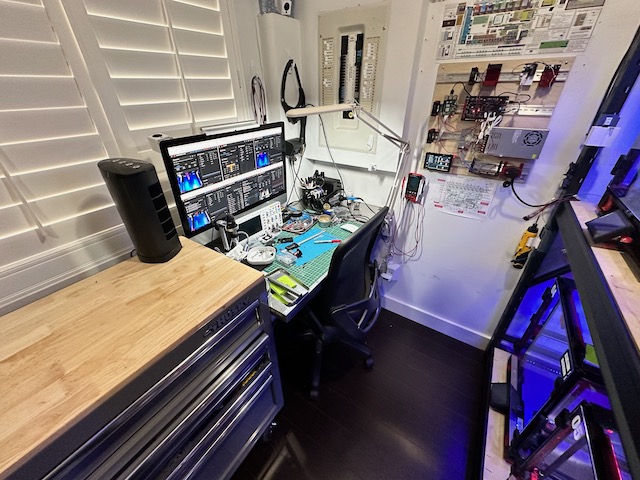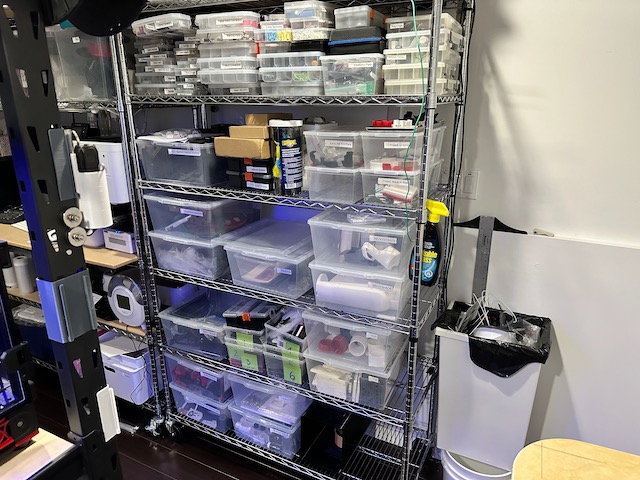My Current 3D Printing Setup (Fall 2025)
As of fall 2025, I’ve really settled into using my printers primarily for testing and refining my designs, rather than producing parts for sale. I still like having a variety of machines from different manufacturers—it helps me understand how others will experience my designs—but that advantage is shrinking as the latest printers have become remarkably consistent and reliable.
When I think back to my first JG Aurora bed-slingers, it’s amazing how far things have come. Modern printers are so much more trouble-free (relatively speaking). That’s probably why I still hang onto my Anycubic K3—it’s the only bed-slinger I have left, and it prints beautifully. Honestly, it’s a great machine.
Why I Use Multiple Printers
Expanding my printer lineup has allowed me to test my designs across different systems and anticipate how others will experience them. My goals are to:
- Ensure reliability – So anyone downloading my designs can print them successfully.
- Provide support – To better understand a wide range of machines and assist users if they run into printing challenges.
- Evaluate performance – To identify which printers truly stand out based on real-world use.
My Printers (as of October 2025)
- Voron r2.4
- Bambu Lab H2D with AMS
- Bambu Lab X1 Carbon with AMS
- Creality K2 with AMS
- Anycubic S1 with AMS
- Anycubic Kobra 3 with AMS
- Elegoo Centauri Carbon
I’m at my space limit for machines right now, but I’m always thinking about which one might need to go next to make room for something new.
Choosing a 3D Printer
If you’re thinking about buying your first printer—or adding another one—here are a few notes from my experience.
Multi-Filament Is the Future
I wouldn’t buy a printer today without AMS or multi-filament capability. Even if you start with single-color prints, you’ll quickly want multi-material flexibility. All major manufacturers now offer this, so budget a little extra for it.
The Short Version
- Voron printers are a special breed—you build, configure, and tune them yourself, supported by a huge community. If you enjoy the process, they’re incredibly rewarding.
- Most people, though, just want a printer that works—and works well.
The Bambu Lab Factor
After testing many machines, I’ve joined the chorus: Bambu Lab makes fantastic printers. If I begin reducing my fleet, it’ll be to focus on their lineup—especially the H2D.
The H2D is an amazing printer and hits all my “super-nerd” buttons. Its dual print heads let you run two filaments without an AMS, and since most of my work involves one or two materials, that’s perfect. You can always add AMS later.
That said, the price is steep—you could buy four excellent printers for the cost of one H2D. So while it’s my top choice for performance, it’s not the best value for everyone.
Other Solid Options
Every machine I own performs well. If you find a deal or prefer a specific brand, you probably won’t regret it.
Even my Elegoo Centauri Carbon has been a pleasant surprise—it’s a great printer for TPU, ABS, or PETG and runs reliably for long sessions.
Still, nothing matches the print quality of the Bambu Lab X1C or H2D. If you have the budget, they’re my recommendation.
Things to Consider Before Buying
Space and Organization
Your printing space is more important than you might think. Even enclosed printers make some noise, so put them where they won’t disrupt your home life (or your sleep).
You’ll also need:
- Room for the printer and AMS if applicable
- A work area for post-processing and assembly
- Storage for filament, spare parts, and finished prints
- Access to all sides of the printer
If you plan to sell products, you’ll also need space for packaging and shipping.

I use 77″ W × 78″ H × 24″ D heavy-duty industrial shelving from Home Depot. I replaced the wire shelves with plywood for a sturdier surface and configured two-shelf setups so printers fit comfortably on both levels. I store filament above the printers—space efficiency is everything.

Power
I tried calculating power requirements but ultimately went with the trial-and-error breaker test. With several machines sharing a 15 A circuit, starting more than four or five at once would trip it. My solution: a dedicated 15 A circuit per three printers—works perfectly.
Ventilation
Air quality matters. With multiple printers running, filters alone weren’t enough, so I built a ventilation system using 2.5″ exhaust lines merging into a wall port, assisted by a 4″ fan for negative pressure. It works extremely well—and yes, I designed my own quick-release fittings, Y-joint, and wall port (all of those designs are posted and available for downloading here).

Lighting
I underestimated lighting at first—both inside the machines and around them. Some of the newer printers are getting better internal lighting, but in most cases, more and brighter would still be welcome.
I’ve also never understood why so many printers use tinted windows, which only make it harder to see what’s happening inside. Fortunately, it’s often possible to add extra illumination using LED strip lights, though every machine is a little different, so you’ll want to look around online to see what others have done for your model.
Just as important is overall room lighting. Even if your workspace gets plenty of daylight, you’ll still need solid artificial lighting for evenings and late-night prints. Good lighting makes a big difference in spotting print issues early and keeping your workspace enjoyable to use.
